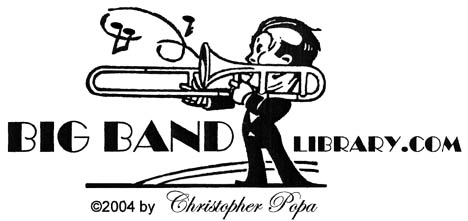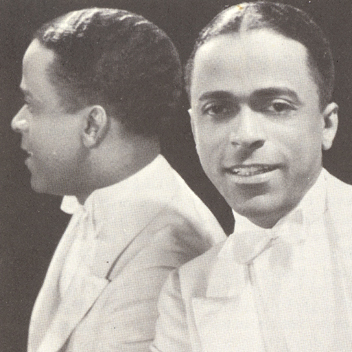
Occasionally they traveled elsewhere, crossing into Canada in 1936 and heading farther out West (Kansas City, MO; Omaha, NE; Sioux Falls, SD; Denver, CO; etc.).
"Claude's approach was basic and, as it turned out, ideally suited to radio and the listening audience of the times," observed author Warren Vache, Sr., in his biography of Hopkins. "He emphasized rhythm that was never heavy, but had an infectious lilt that invited toe-tapping. The accent was always on the melody, with the saxes blending in a sliding, sensuous mode that was almost a croon. He kept the brass at a subdued level, too."
Later, Vache continued, when the time was right, "The mutes came out, the tempos went up, and the waltzes and ballads gave way to jazz and swing."
vital stats:
given name Claude Driskett Hopkins
birth Aug. 12, 1898 (or Aug. 3, 1903?; or Aug. 24, 1906?), Alexandria, VA (or Washington,
DC?)
death Feb. 19 (or Feb.22?), 1984, New York City
father Albert W. Hopkins, a supervisor of a school for orphan boys and later the postmaster
at Howard University, Washington, DC
mother Gertrude D. Hopkins, supervisor of a school for orphan boys and later the matron of
Clarke Hall, one of the dormitories at Howard University, Washington, DC
education public schools, Washington, DC; graduate, B.A., Howard University, Washington,
DC
extracurricular activities sports (basketball, football, baseball, track, tennis)
wife Mabel, a dancer, m.1922?, d.Jan. 1972
son Claude Hopkins, Jr., b.ca.1954?
membership ASCAP, 1944-
automobiles "an old Buick touring car" (1925); a Ford Model T (1928); a Lincoln (1932); a
Dodge (1937); a Chrysler (1948), a Pontiac station wagon (1951)
residence 507 W. 152nd St., New York City (1950s)
physical description "Impeccably groomed, tall, handsome, and sophisticated"
The members of Hopkins' band included, at various times, Ovie Alston and Jabbo Smith, trumpets; Vic Dickenson and Fred Norman, trombones; Edmond Hall, clarinet; Gene Johnson, alto saxophonist; Bobby Sands, tenor saxophone; and Pete Jacobs, drums.
Hopkins and his band recorded for Columbia (1932-34), Brunswick (1934), Decca (1934-35 and 1937), Vocalion (1938, under Ovie Alston's name), and Ammor (1940).
Discs considered among Hopkins' best are (I Would Do) Anything for You, his most famous composition; Mush Mouth, a Jimmy Mundy arrangement; and Trees, sung by the high tenor vocalist Orlando Robeson.
Hopkins' big band broke up in 1940, and he decided to file for bankruptcy the following year.
"He claimed his liabilities amounted to $3,770 and his assets $10,866. Hopkins said he owed his musicians $295 and the Wm. Morris agency $750. His assets include $2,741 in debts owed him, $4,000 in insurance policies, and $4,050 in exempt properties," it was stated in Down Beat.
Claude Hopkins - In His Own Words
"The radio made audiences for you when you went on tour. Wednesday night might be the best night
in one town, and maybe I'd play there this week. Then two weeks later Earl Hines would come in. That
way the people stayed hungry, and were always ready to listen."
"I did as many of the arrangements as I could, but I had to get Bill Challis to make some. Fred Norman,
who made a career as an arranger, joined me at Roseland on trombone . . . "
"Orlando Roberson was doing those falsetto vocals before Jimmie Lunceford got on it, and Nick Kenny
of the Ink Spots got it from Orlando, too. It was strange, I admit, strange as a woman singing bass,
but it was very popular. I also had Ovie Alston . . . He was a nice little trumpet player and he had a
nice little voice, too."
"I've sure had the full treatment of the business, but I just can't sit down and do nothing. I'll always
keep going."
Evidently to earn some money, Hopkins offered his services as an arranger to other leaders in 1941, including Raymond Scott, Phil Spitalny, Tommy Tucker, and Abe Lyman.
Hopkins also spent time during World War II working as an aircraft inspector and mechanic at the Eastern Aircraft factory (formerly a General Motors assembly facility) in Linden, NJ.
But by 1944, he was back on the bandstand, forming an 11-piece orchestra for a residency at Club Broadway in New York City, then leading groups of varying sizes at the Club Zanzibar in New York City for three years.
Next, he led a "novelty quintet" on tour in 1948-49 and a combo at Cafe Society in New York City in 1950-51, then, during the next three decades, worked with various musicians as a pianist at club, concert, and festival performances (such as trumpeter Roy Eldridge's group at Jimmy Ryan's in New York City for several years, or later when Hopkins toured Europe with trombonist Dicky Wells and saxophonist Earle Warren, who had been part of Count Basie's orchestra in the 1930s and '40s).
In 1970, Gene Fernett authored a book celebrating many prominent African-American orchestras, including Hopkins', and commented, "Hopefully, there may come a day when he will choose to once again front a big band."
That didn't happen, but Hopkins had continued to record, making some enjoyable LPs for the Swingville label in the 1960s ("Yes, Indeed!"; "Let's Jam"; and "Swing Time"), and, in 1973, a fine solo piano album on Chiaroscuro ("Crazy Fingers").
Looking back on Hopkins' career, critics Leonard Feather and Ira Gitler later wrote that he had remained a "master of stride with a lyrical bent and consistent sense of swing."
sources:
Stanley Dance, "Claude Hopkins-Bandleader [Piano and Arranger], in The World of Swing
(New York City: Charles Scribner's Sons, 1974), pp.31-44.
Frank Driggs, LP liner notes, "Singin' in the Rain: Claude Hopkins and His Cotton Club
Orchestra," Jazz Archives JA-27.
Leonard Feather, "Hopkins, Claude," in The Encyclopedia of Jazz (New York City: Horizon
Press, 1955), p.259.
---, "Hopkins, Claude," in The Encyclopedia of Jazz in the Seventies (New York City:
Horizon Press, 1976), p.179.
Leonard Feather and Ira Gitler, "Hopkins, Claude Driskett," in The Biographical
Encyclopedia of Jazz (New York City: Oxford University Press, Inc., 1999), p.329.
Gene Fernett, "Chapter XXII: Claude Hopkins," in Swing Out: Great Negro Dance Bands
(Midland, MI: Pendell Pub. Co., 1970), pp.109-110.
"Hopkins, Claude," in ASCAP Biographical Dictionary, Fourth Edition (New York City: R.R.
Bowker Company, 1980), p.235.
"Once a Big Name, Hopkins Now Bankrupt," Down Beat, May 1, 1941.
Social Security Death Index.
Warren Vache, Sr., Crazy Fingers: Claude Hopkins' Life in Jazz (Washington, DC:
Smithsonian Institution Press, 1992).
---, "'I Would Do Anything For You': The Story of Claude Hopkins: Part I," Mississippi Rag,
Feb. 1986, pp.1-4.
---, "'I Would Do Anything For You': The Story of Claude Hopkins: Part II," Mississippi Rag,
Mar. 1986, pp.8-11.
---, "The Story of Claude Hopkins: Part III," Mississippi Rag, Apr. 1986, pp.10-13.
I would like to expand this tribute with, if possible, a new interview of someone who was important to Claude Hopkins' life or career. Are you an alumnus of his band, a member of his family, or a collector who is knowledgeable about his accomplishments? Please contact me via e-mail
return to "Biographical Sketches" directory
go to Big Band Library homepage
The big bands are back
in a new and exciting way!
CLAUDE HOPKINS
"REFLECTIONS IN SWING "
by Music Librarian CHRISTOPHER POPA
April 2009
He was a pianist and composer who, in 1925, was hired as the musical director for La Revue Negre, which launched the career of singer-dance-actress Josephine Baker.
His own big band performed between 1931 and 1936 at such prestigious spots as the Savoy and Roseland ballrooms and the Cotton Club in New York City.
Hopkins and his musicians also appeared in the Midwest and the South, mostly, performing on one-nighters, in ballrooms and theaters, broadcasting over the radio, appearing in a couple feature films and shorts, and making some good records.
